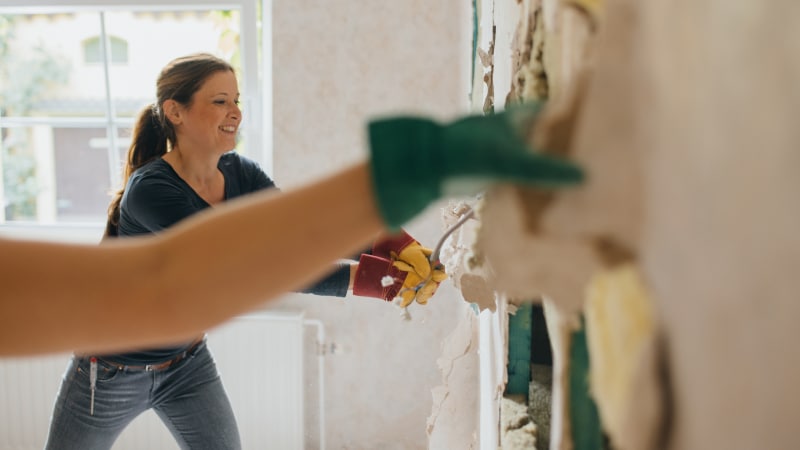5 ways to pay off your bathroom remodel

This article is for educational purposes only. JPMorgan Chase Bank N.A. does not offer Home Equity Loans nor Home Equity Lines of Credit (HELOC) at this time. Please visit our HELOC page for future updates. Any information described in this article may vary by lender.
Whether you're buying a home that you plan to customize or you want to remodel your existing home, taking on a bathroom renovation comes with some costs. A basic bathroom remodel costs anywhere between $11,579 and $40,800, according to data gathered from Kukun. Labor and materials can make up as much as 20% of those costs.
Your layout, design, features, labor and materials will affect the total cost, so it's no surprise that many homeowners look for ways to save on their bathroom remodel.
Benefits of a bathroom remodel
The cost of remodeling your bathroom can come with some benefits. First, the National Association of Realtors reports that a bathroom remodel can offer up to 57% or more return on your investment, depending on where you live and how much you spend on the project. It's also interesting to note that 35% of bathroom remodels had a direct impact on improved functionality and livability.
The benefits are clear, but they also come with costs. There are several ways you can pay for a bathroom remodel
1. Cash and liquid assets
One way to pay for your bathroom remodel is with cash or any liquid assets you can access quickly. Checking and savings accounts, mutual funds, savings bonds and certificates of deposit near maturity are all types of readily available liquid assets you can use to cover the entire cost of your remodel.
You can also split your renovation costs between cash and credit to reduce the amount of interest you’d pay using credit alone.
2. Apply for a home equity line of credit
A home equity line of credit (HELOC) is a financing option that provides you with a credit limit equal to an equity portion of your current home value. The amount of your HELOC can depend on your home's current value and how much home equity you have, but the advantage of this option is that it's flexible.
Because a HELOC acts as a revolving loan, it works like a credit card. You're able to spend the line of credit and pay it off multiple times throughout the lifetime of the loan. This means you can take out only the amount you need for your bathroom renovation project.
3. Take out a home equity loan
A home equity loan is another option you can use to pay off your bathroom remodel. This is a loan taken against the value of your home's current equity. A home equity loan differs from a HELOC in that it offers fixed interest rates and loan terms.
A home equity loan can be beneficial for paying for your bathroom renovation, especially if you're able to pay off the total costs of your project within three to five years.
4. Cash-out refinance
A cash-out refinance is another option for paying off your bathroom remodel costs. It’s a new first mortgage and, depending when you refinance, your new interest rate may even be less than your existing rate.
A cash-out refinance may also come with a fixed interest rate for a fixed term. Lower interest rates can mean potentially lower monthly payments, so a cash-out refinance might be worth looking into as an option for paying off your bathroom remodel costs.
5. FHA 203(k) home improvement loan
The FHA oversees the 203(k) program, a government-funded home renovation loan program. This loan is available for homeowners planning to renovate or upgrade their current home's features. The 203(k) has upfront mortgage insurance premiums along with monthly premiums that stay for the loan's entire lifetime. One key aspect of this renovation loan is the ability to borrow against your home's future value, rather than its current value. This means that you could take out a 203(k) that amounts to more than your home's current value.
The FHA 203(k) improvement loan has two distinct options for homeowners to apply for. One is a limited 203(k) that only covers up to a certain amount in renovation costs. Additionally, this option excludes structural, health, and safety remodels. The advantage of the limited 203(k) option is that it doesn't require as many inspections during the project as the full 203(k) loan often does.
The full 203(k) option lets borrowers use as much of the loan as you need to in order to complete your renovation project. This option does include structural, health and safety renovations.
Ways to save on your bathroom renovation
Regardless of how you choose to finance your bathroom renovation, there are always ways you can save money. You might think about the following cost-saving strategies to help reduce your total renovation bill:
- Keep the original layout. This avoids the added costs of rearrange plumbing, electrical, and bathroom fixtures like the toilet or bathtub.
- Put in some sweat equity. Do some of the bathroom renovation yourself. Some people can even install fixtures like faucets, lights, mirrors, and vanities with the right tools.
- Fake it. Opt for stock bathroom fixtures in aesthetic finishes like brushed nickel, bronze, or stainless steel. This way you'll be able to get the look of custom features for less.
- Keep it simple. Opt for durable vinyl, laminate, or affordable tile rather than custom tiles. It's an easy way to save on the costs of your renovation materials.



